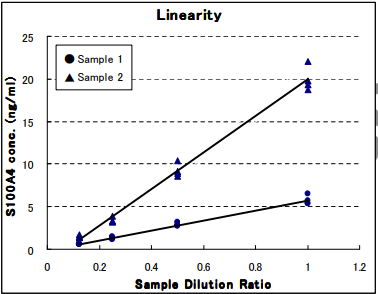CircuLex S100A4 ELISA Kit Ver.2
| Code | Size | Price |
|---|
| MBL-CY-8086 | 96 Assays | £602.00 |
Quantity:
Prices exclude any Taxes / VAT
Overview
Regulatory Status: RUO
Application: Enzyme-Linked Immunosorbent Assay (ELISA)
Shipping:
4°C
Storage:
4°C
Images
Documents
Further Information
Background:
Members of the S100 protein family are low molecular mass acidic proteins characterized by
cell-type-specific expression and the presence of 2 EF-hand calcium-binding domains with different
affinities for calcium (1). Elevated levels of one S100 protein, S100A4, are closely associated with the
process of metastasis in breast and other cancer cells in rodent animal models and in human cancer
specimens. S100A4 or its mRNA is found at an elevated level in metastatic relative to non-metastatic rat
(2) and mouse (3) tumor cell lines and malignant relative to benign human breast tumors (4). Elevation
of the level of rat (5) or human (6) S100A4 in benign rat mammary tumor cells results in the acquisition
of metastatic capability by some of the cells. In transgenic mouse models of breast cancer, elevated
levels of S100A4 in neu oncogene-induced (7), or in murine mammary tumor virus-induced (8), benign
mammary tumors yield lung metastases. In colorectal adenocarcinoma specimens, elevated levels of
immunocytochemically detected S100A4 are associated with the more malignant carcinomatous regions
of the primary tumors and with liver metastases (9).
Description:
The CycLex Research Product Circulex S100A4 ELISA kit is used for the quantitative measurement
of human S100A4 in cell extract, tissue culture medium and other biological media.
Kit Components:
Microplate, 10X Wash Buffer, Dilution Buffer, S100A4 Standard, HRP conjugated Detection Antibody, Substrate Reagent, Stop Solution
Measurement Range:
0.375 ng/mL to 24 ng/mL
Sensitivity:
better than 0.28 ng/ml of sample.
Target:
S100A4
References
1. Hilt, D., and Kligman, D. (1991) in Novel Calcium-binding Proteins: Fundamentals and Clinical
Implications (Heizmann, C. W., ed) , pp. 65-103, Springer-Verlag, Berlin
2. Dunnington, D. J. (1984) The Development and Study of Single Cell-cloned Metastasizing Mammary
Tumour Cell Systems in the Rat. Ph.D. thesis , University of London
3. Ebralidze, A., Tulchinsky, E., Grigorian, M., Afanayeva, A., Senin, V., Revazova, E., and Lukanidin, E.
(1989) Genes Dev. 3, 1086-1093
4. Nikitenko, L., Lloyd, B., Rudland, P., Fear, S., and Barraclough, R. (2000) Int. J. Cancer 86, in press
5. Davies, B., Davies, M., Gibbs, F., Barraclough, R., and Rudland, P. (1993) Oncogene 8, 999-1008
6. Lloyd, B., Platt-Higgins, A., Rudland, P., and Barraclough, R. (1998) Oncogene 17, 465-473
7. Davies, M., Rudland, P., Robertson, L., Parry, E., Jolicoeur, P., and Barraclough, R. (1996) Oncogene
13, 1631-1637
8. Ambartsumian, N., Grigorian, M., Larsen, F., Karlstrom, O., Sidenius, N., Rygaard, J., Georgiev, G.,
and Lukanidin, E. (1996) Oncogene 13, 1621-1630
9. Takenaga, K., Nakanishi, H., Wada, K., Suzuki, M., Matsuzaki, O., Matsuura, A., and Endo, H. (1997)
Clin. Cancer Res. 3, 2309-2316





